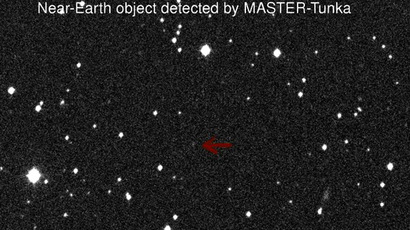European space probe to attempt comet landing

In an unprecedented mission, the European Space Agency (ESA) plans to land an unmanned spacecraft on a comet next year in a very tricky maneuver.
The Rosetta probe, which has been traveling through space since
its launch in 2004, will attempt to drop a lander onto the
surface of an icy comet - known as 67P/Churyumov-Gerasimenko - on
November 11, 2014.
Scientists will attempt to fly the probe alongside the comet and
send down the barrel-sized lander, which is equipped with drills,
to analyze samples from the comet’s surface.
“Nobody has ever done this before,” Paolo Ferri, head of
mission operations at the European Space Agency, said on Tuesday.
Rosetta has been practicing the maneuver during fly-bys of Earth,
Mars, and the Sun. More than two years ago, when the probe was on
course to rendezvous with the comet, the ESA put it into
hibernation to conserve energy.
This also gave engineers much needed time to attempt to fix two
malfunctions that threatened the mission: a problem with two of
the four reaction wheels used to turn the spacecraft, and a
helium leak that affects the thrusters, which are vital for its
final maneuvers.
If Rosetta’s alarm goes off as planned on January 20 2014, she
will be 800 million kilometers from Earth. And by November 2014,
she will have hopefully found 67P - which orbits the sun at up to
100,000 kilometers per hour - and will launch the landing barrel
called Philae.
Philae will then glide down to the surface of the comet and latch
onto it with a harpoon to prevent it from drifting off into
space.
Scientists say they hope to understand how comets have remained
pretty much unchanged since our solar system was formed, and
whether comets are responsible for the water on Earth.
“This time capsule’s been locked away for 4.6 billion
years,” said Mark McCaughrean, the ESA’s director of
science.
Once launched, Philae’s lifespan on the Comet could be as short
as three days. Rosetta is unlikely to survive beyond late 2016.
Although the US space agency (NASA) managed to land a probe on an
asteroid in 2001, a landing on a comet is harder because they are
much more volatile and their dust and gases can damage
spacecraft.
NASA’s 2005 Deep Impact mission fired a projectile onto a comet
to create a plume of matter for scientists to study. However,
that mission was a mere drive-by shooting compared to the bank
robbery planned by the ESA. The Deep Impact spacecraft eventually
lost contact with controllers in September.
Meanwhile, the US space agency has plans of its own. It is set to
attempt an extremely ambitious mission to lasso a small asteroid
close to the Moon between 2019 and 2021, so that space-walking
astronauts can explore it.














